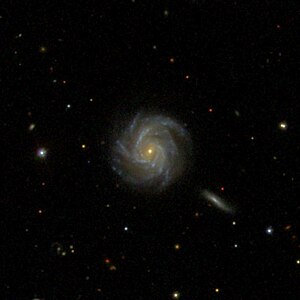NGC 6001
| Galaxy NGC 6001 |
|
|---|---|

|
|
| SDSS recording | |
| AladinLite | |
| Constellation | Northern crown |
|
Position equinox : J2000.0 , epoch : J2000.0 |
|
| Right ascension | 15 h 47 m 45.9 s |
| declination | + 28 ° 38 ′ 30 ″ |
| Appearance | |
| Morphological type | Sc |
| Brightness (visual) | 13.7 mag |
| Brightness (B-band) | 14.4 mag |
| Angular expansion | 1.0 ′ × 1.0 ′ |
| Surface brightness | 13.6 mag / arcmin² |
| Physical data | |
| Redshift | 0.033224 ± 0.000074 |
| Radial velocity | (9960 ± 22) km / s |
|
Stroke distance v rad / H 0 |
(450 ± 32) · 10 6 ly (138.0 ± 9.7) Mpc |
| history | |
| discovery | Wilhelm Herschel |
| Discovery date | April 11, 1785 |
| Catalog names | |
| NGC 6001 • UGC 10036 • PGC 56056 • CGCG 166-058 • MCG + 05-37-27 • IRAS 15457 + 2847 • 2MASX J15474595 + 2838306 • GC 4143 • H III 371 • | |
NGC 6001 is a 13.7 likes bright spiral radio galaxy from the Hubble type Sc in the constellation Corona Borealis , the estimated 450 million light-years from the Milky Way 's center. Together with the approximately 465 million light-years distant galaxy PGC 56051 (which is occasionally incorrectly identified as NGC 6002 ) it forms an optical double galaxy.
The object was discovered on April 11, 1785 by Wilhelm Herschel with an 18.7-inch reflector telescope, who described it as "vF, S, R, verified with 240 power easily".
